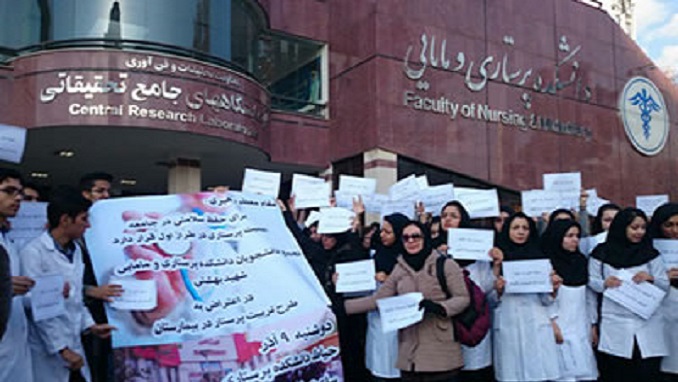
According to the latest figures about the protests held in Iran, an average of 20 protests take place daily. One of the most active sectors in these protest activities are the nurses. Despite their heavy-duty involving a lot of work, pressure, and harms, the majority of the nurses in Iran do not have official employment. They are all on temporary contracts. They receive a very small salary that it is not even regularly paid.
The latest protest by nurses was held in Boushehr on August 24, 2017, where their main reason for protesting was the fact that they haven’t received their paychecks for eight months. Women nurses in Semnan also protested on July 16 and 17, 2017, in front of the Governor’s Office in this city to demand 11 months of past due salaries. The nurses and staff of one of the hospitals in Yasouj also held a protest on May 30, 2017, for six months of non-paid salary. Other protests have been also held all across the country throughout the year.
The Vice-President of the Nursing Organization had to accept the fact that although the nurses are forced to work overtime, their overtime fees had not been paid for between six to ten months.
Nurses do not get their salaries, and even the regime officials have acknowledged that in the past 1.5 years, at least 16 educated nurses between 25 and 45 years of age have died at their workplace due to the pressure of working different shifts, leading to heart stroke and other fatal problems.
According to some reports, there are at least 11,000 unemployed nurses in Iran. The President of the Nursing Organization has admitted that some 40,000 unemployed nurses have registered at the organization’s website who do not want to continue their work due to lack of security. The official pointed out that there is an increasing absence of government support for nurses, and they have to endure tremendous pressure at work while receiving small salaries.
The Vice-President of the Nursing Organization has also indicated that there is a wide gap in the salaries of nurses and doctors. “The difference in the salaries of a nurse and a doctor in 99 per cent of countries, is three folds at most. In Iran, however, the difference is 100 folds. We have even had payrolls that are 500 times greater than those of nurses.”
At the same time, the number of graduates of nursing is not small, but there are many who do not get employment licenses after graduation. This is why many nurses decide to migrate despite the rampant shortage of nurses in the country.
Instead of compensating for the shortage of nurses in hospitals, official employment of educated nurses, reducing the gap between doctors and nurses’ salaries, paying benefits for harmful jobs, and issuing license for the employment of educated nurses, the Ministry of Health has offered a plan according to which hospitals with sufficient facilities are allowed to train nurses. The plan of the Ministry of Health for training nurses in the hospitals was first announced two years ago. On May 13, 2017, the ministry renewed the directive on this plan.
Instead of making nurses’ employment official resolve the critical shortage of nurses in hospitals, the Health Ministry wants to use the untrained graduates as cheap labor forces, activists of the nursing community say. They claim that thousands of nurses are working on unofficial contracts despite years of experience in this field and the Health Ministry plan will jeopardize their job security.
In addition, some experts believe that the plan will take back the nursing profession 50 years.
Iran’s nursing community organized nationwide protests on August 6, 2017, against the Health Ministry’s plan. The protesters in Tehran, Shiraz, Isfahan, Ahwaz, Bojnourd, and Hormuzgan asked for termination of the plan which provides for training nurses in hospitals against all academic standards. They said they will continue their protests until they reach their demands.
